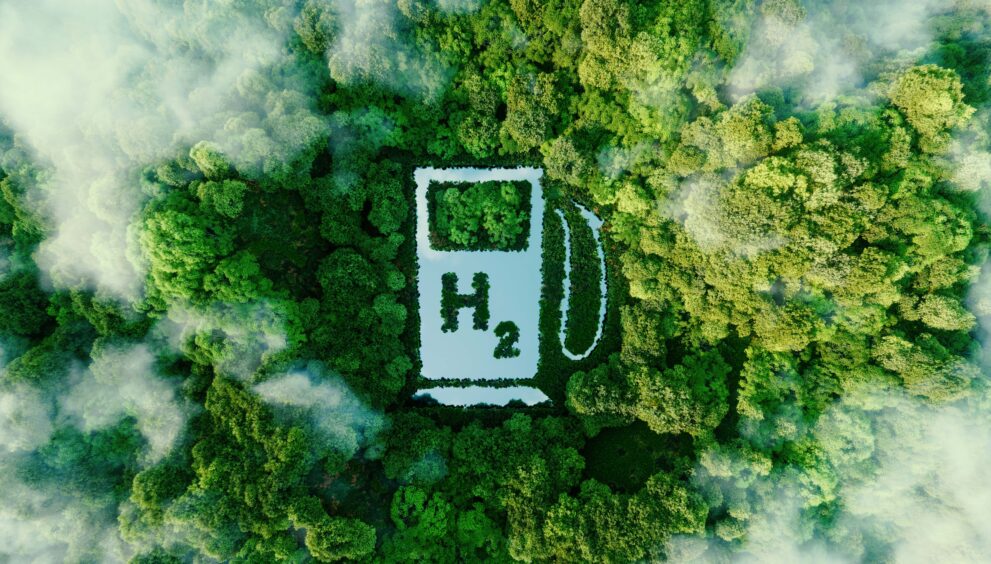BHU Develops Tech That Can Boost Green Hydrogen Production

summary: The technology developed by the team comprising of Dr. Somenath Garai and Prof. S. Srikrishna showcased the uses of Green Hydrogen as eco-friendly energy alternatives
A new high throughput quantum-backed green hydrogen production technique was created by the Green Keplerate team at Banaras Hindu University, and it has the potential to increase green hydrogen production in bulk.
The technology created by the group that included S. Srikrishna and Somnath Garai demonstrated the uses of Green Hydrogen as an environmentally friendly energy substitutes. They presented quantum catalytic applications for energy production and unveiled the next-generation quantum-powered photo-catalyst with a charge transfer mechanism paired with high proton availability and mobility.
This technology’s patent application is currently pending and was made possible by the Hydrogen and Fuel Cell program’s “Boosting the H2 Economy by Harnessing the Merits of Quantum Encapsulation Chemistry: Augmented Kinetics for Water Splitting Reaction Under Confinement” project.
Modern photochemical reactors have built-in illumination systems and concave external reflective panels to optimise solar energy absorption. After extensive optimisation, the team was able to produce green hydrogen at a lab scale at a peak rate of about 1 litre/min per 10 g of quantum photocatalysts using a continuous electron coupled proton supply system propelled by an electron injector mechanism using industrial metal waste.
The fuel can be used without further purification due to the high purity of the hydrogen gas generated, which increases the cost-effectiveness of the technique.
Green Hydrogen can play a critical role in decarbonising the transportation sector by fueling fuel-cell vehicles. According to a study by the Indian government, fuel cell vehicles powered by Green Hydrogen could save around 1 billion litres of diesel and reduce carbon dioxide emissions by 2.8 million tons by 2030.
India has already taken some steps to promote the use of fuel-cell vehicles. In 2018, the country launched its National Hydrogen Energy Mission, which aims to develop a hydrogen economy and promote the use of fuel-cell vehicles. Moreover, the Indian government aimed to launch a pilot project for hydrogen-powered buses in the city of Delhi.
One of the most significant advantages of hydrogen cars is their minimal environmental impact. With zero tailpipe emissions, hydrogen cars contribute to improving air quality and reducing India’s carbon footprint, especially in congested urban areas. Hydrogen cars typically offer longer driving ranges on a single full talk compared to electric vehicles (EVs). This feature is crucial in a country as vast as India, where long-distance travel is common, and charging infrastructure is still developing. Hydrogen fuel cell cars provide full power even at low speeds.
Unlike traditional cars with internal combustion engines, Fuel Cell Electric Vehicles (FCEVs) operate quietly, similar to electric cars. So green hydrogen cars are not only good for reducing environmental pollution but also noise pollution.
Hydrogen refuelling stations can fill a hydrogen tank in a matter of minutes, similar to the time it takes to refuel a gasoline or diesel vehicle. This quick refuelling time addresses one of the key concerns associated with EVs – lengthy charging periods.
Unlike Electric Vehicles, the driving efficiency of hydrogen cars remains consistent regardless of the outside temperature. In an electric car, the efficiency drastically falls when it’s used in cold weather conditions.
Hydrogen can be used in various modes of transportation, from cars and buses to trucks and trains. This versatility makes hydrogen an attractive option for India’s diverse transportation needs.























































































































































































































































































































































































































































































































































































































































































































































































































































































































































































































































































































